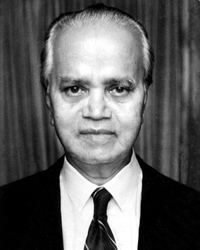Name Abdur Biswas Religion Sunni Islam | ||
 | ||
Born 1 September 1926 (age 99) Shaistabad, Barisal, Bengal Presidency, British India(now in Bangladesh) ( 1926-09-01 ) Party Bangladesh Nationalist Party Presidential term October 10, 1991 – October 9, 1996 Similar People A Q M Badruddoza Chowdhury, Muhammad Habibur Rahman, Ziaur Rahman, Hussain Muhammad Ershad, Mahi B Chowdhury | ||
Bangladesh - Interview With President
Abdur Rahman Biswas (Bengali: আবদুর রহমান বিশ্বাস; born 1 September 1926) was the 11th President of Bangladesh during 1991 to 1996.
Contents
- Bangladesh Interview With President
- Former President of Bangladesh Abdur Rahman Biswas is no more
- Early life and education
- Political career
- President of Bangladesh
- February 1996 election
- June 1996 election
- 1996 coup
- Later life
- References
Former President of Bangladesh Abdur Rahman Biswas is no more
Early life and education
Biswas was born in the village of Shaistabad, Barisal District. He was educated at Dhaka University, where he received history degrees a BA with honours and a MA in history and a degree in law. His subsequent public service included chairing a local cooperative bank and sponsoring educational initiatives.
Political career
Biswas was elected as a representative to the East Pakistan Legislative Assembly in 1962 and 1965. In 1967 he represented Pakistan at the UN General Assembly. Bangladesh held general elections in 1979, in which Biswas obtained a seat in its parliament (Jatiyo Sangsad). He held posts in its ministries. His seat in the parliament was confirmed during a 1991 election and soon afterwards he was chosen as Speaker of the Parliament.
President of Bangladesh
For most of his tenure as President, Biswas spent his time reading and meeting dignitaries including Nobel laureate physicist Abdus Salam, Prime Minister of Pakistan, Nawaz Sharif, the Prime Minister of Nepal, Jigme Singye Wangchuck, the King of Bhutan and the Malaysian Prime Minister Mahathir Bin Mohamad. As head of the Caretaker government of Bangladesh, however, he faced challenges from the military and political instability in the country.
February 1996 election
From mid-1994, clashes between the BNP backed Jatioabadi Chhatra Dal and Awami League backed Bangladesh Chhatra League led to increasing violence in the form bomb and arson attacks on party bureaus, newspaper offices and government buildings. In the midst of violence, the opposition led by the Awami League's Sheikh Hasina, pledged to boycott national elections scheduled for 15 February 1996. When Khaleda Zia's BNP was re-elected for the second term in that election, it was boycotted and denounced by the three main opposition parties. On 26 March, in the face of increasing opposition, the newly elected parliament enacted the thirteenth constitutional amendment bill paving the way for the appointment of an interim caretaker government.
June 1996 election
On 28 March 1996, Biswas signed the Caretaker Government bill into law, which was welcomed by human rights organisations. As a result, Biswas dissolved the newly-elected legislature and, as Khaleda Zia stepped down, while appointed former Chief Justice Habibur Rahman was appointed as chief adviser to head an interim government that was poised to preside over fresh national elections on 12 June 1996.
1996 coup
On 19 May 1996, Biswas, as head of a caretaker government, ordered the army chief Lieutenant General Abu Saleh Mohammad Nasim to force the retirement of Major-General Morshed Khan, commander of Bogra Cantonment, and Brigadier Miron Hamidur Rahman, deputy chief of paramilitary Bangladesh Rifles. Both officers had issued statements expressing dissatisfaction with the country's situation. The President believed that they were involved in political activities with opposition parties. Nasim refused to comply. The next day, Biswas sacked him and sent soldiers to control the state radio and television stations. On noon that day, Nasim ordered soldiers of Bogra, Jessore and Mymensingh divisions to march towards Dhaka. The Ninth Infantry Division's Major General Imamuzzaman, who commanded the division located closest to Dhaka, remained loyal to the President. He directed the removal of all boats and ferries from Jamuna River in Aricha port, so that Bogra and Jessore divisions could not cross the river.
Biswas sent a contingent of troops with tanks to blockade the Dhaka-Mymenshing highway. This prevented Mymensing Division Army from entering Dhaka. In the meantime, Major General Mohammad Anwar Hossain, General Officer Commanding of the 33rd Infantry Division located in Comilla, also came to the aid of the president. He mobilised a fully geared 101 Infantry Brigade, under the command of Brigadier Shah Ikram (later Major General) to Dhaka to fortify Bangabhaban, the presidential palace. The 33rd Division was deployed, using an Infantry Battalion and a company of tanks from the 7th Horse Armoured Battalion at the Dhaka-Chittagong highway, to create a blockade against the 24th Infantry Division located in Chittagong. The government broadcast announcements asking all soldiers to stay at their own cantonment. After some hours, Mymensingh Division soldiers returned to their barracks. The Chittagong Division never mobilised towards Dhaka. The General Officer Commanding of the Chittagong Division realised that the military coup was highly unlikely to succeed. That night Nasim was interviewed by the BBC and, in reference to troop movements, he said that as Army Chief, he could move troops anytime he wanted. Nasim was arrested by the Brigade Commander of 14 Independent Engineers Brigade and put under house arrest in the Army Mess behind Army Central Library, Staff road, Dhaka Cantonment. Later the Awami League government, which was elected to power in 1996, granted him a formal retirement. Biswas later recalled the events as his "most memonrable experience." He stepped down as president on 9 October 1996 and was succeeded by Shahabuddin Ahmed.
Later life
After the end of his presidency, Biswas retired permanently from politics. In 2006, during the unfolding crisis, Biswas's house in Barisal was set on fire by Awami League activists.
